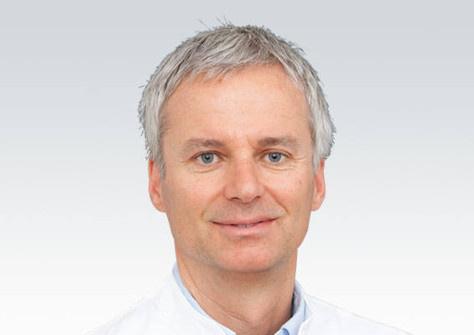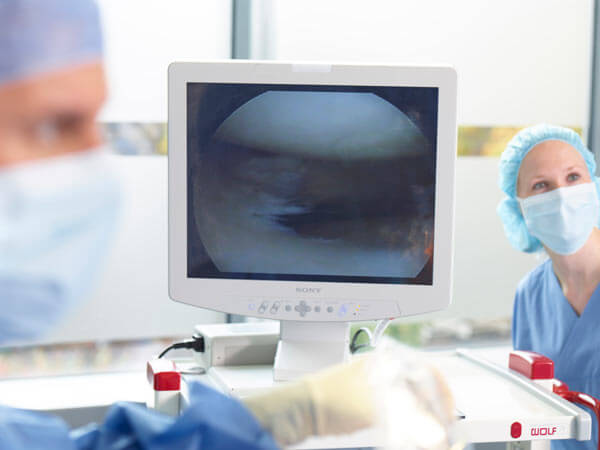Minimal invasive rigid stabilization
Minimal invasive rigid stabilization
Chronic neck pain can have many different causes. The wear and tear, or degeneration, especially the intervertebral discs and facet joints plays a major role. However, instabilities, vertebral fractures, inflammation, misalignment or tumors may be responsible for this. At the lumbar spine, a combined approach is mostly useful and necessary in order to achieve a safe bone strength in formerly movable spine section. Due to the continuous development of medicine, it is already possible to draw even at a fusion surgery to minimally invasive techniques to largely sparing the surrounding tissue.
Professor Dr. med. Lill is an expert in the field of minimally invasive solid stabilization in the region of the lumbar and beck spine! He and his team will assist you during your treatment and tell you everything you want to know about the surgery.
Your advantages at OrthoCenter Munich
- Orthopedic treatment focus on spinetherapy
- Wide range of conservative and operative procedures
- Gentle procedures in focus: Dr. Riedel specializes in gentle pain therapy. He was head physician in various pain clinics for over 20 years
- Joints and surgical expert: Prof. Dr. Lill specializes in the treatment of joints. He has years of experience in the field of minimally invasiveand arthroscopic ops.
- Cooperation with clinics and research institutes worldwide
- Renowned private practice: the OrthoCenter is internationally known and repeatedly welcomes patients from abroad who come to Munich for treatment
Minimally Invasive Solid Stabilization (Cervical Spine)
Is a fusion surgery (spinal fusion) with proven underlying disease in the cervical spine inevitable, it is sufficient in most situations, the affected spinal segment isolated strengthening of the front. Only in exceptional cases a sole rear (screw and rod construction) or combined supply is required.
Therapy
Goal of minimally invasive solid stabilization of the cervical spine from the front is the careful replacement of the intervertebral disc with a supporting token, which is also known as Cage. Unlike intervertebral disc prostheses that Cage does not admit any mobility in the spine section supplied. The cages consist mostly well acceptable and highly stable plastic (PEEK) or a titanium alloy. They are filled with autologous bone or a bone man-made, so that in the course of a few months a bony connection (block) between the two vertebral bodies occurs. Access to the anterior cervical spine is very gentle tissue and occurs over a few centimeters long incision on the neck. While sparing the surrounding soft tissue, the surgeon gets truncated on the replaceable disc. This is then completely removed and relieves the spinal cord as a result. Under X-ray control of filled with bone Cage is now fitted. The surgical procedure is performed under general anesthesia in the supine position and takes about 90 minutes. Already after 8 hours is first started mobilizing under assistance.
Rehabilitation
In the first six weeks after surgical intervention, we recommend physical indulgence. This includes wearing a specially adapted soft cervical collar, which relieves the neck and supports the healing. Targeted physiotherapy treatment should be needed in the aftermath, if necessary, physical measures in the treatment of muscle tension can be performed concomitantly. After a period of eight to ten weeks, the usual activities at work and play can be resumed.
Lumbar Spine
Is a fusion surgery (spinal fusion) with proven underlying disease inevitable, it is important to strengthen the affected spinal segment back and forth. In exceptional cases, a sole front (Cage) or rear (screw and rod construction) is sufficient.
Therapy
Goal of minimally invasive solid stabilization of the lumbar spine from the front is the tissue sparing replacement of the intervertebral disc with a supporting token, which is also known as Cage. Unlike intervertebral disc prostheses that Cage does not admit any mobility in the spine section supplied. The cages consist mostly well acceptable and highly stable plastic (PEEK) or a titanium alloy. They are filled with autologous bone or a bone man-made, so that in the course of a few months a bony connection (block) between the two vertebral bodies occurs. The minimally invasive access to the anterior lumbar spine using either a few centimeters long horizontal or lateral applied centrally located incision over the iliac crest. While sparing the surrounding abdominal organs, the surgeon gets dull on the affected intervertebral disc. This is then completely removed and replaced under fluoroscopic control through a Cage. The surgical procedure is performed under general anesthesia in the supine position and takes about 90 minutes. Already after 8 hours is first started mobilizing under assistance.
Rehabilitation
In the first twelve weeks after surgical intervention, we recommend physical indulgence. This includes the wearing of a specially adapted stable hull corsets, which relieves the back and support the healing of the inserted implant. After twelve weeks shall physiotherapy treatment measures under the guidance be commenced to build up again the core muscles and strengthen . An outpatient or inpatient Rehabilitationsmaßnahe can support this measure and is useful. This guarantees to be able to promptly take the usual activities at work and play again. Depending on the physical load, the working capacity is four to five months made after surgical intervention again.
Lumbar Spine (perkutan)
Is a fusion surgery (spinal fusion) with proven underlying disease inevitable, it is important to strengthen the affected spinal segment back and forth. In exceptional cases, a sole front (Cage) or rear (screw and rod construction) is sufficient.
Therapy
Goal of minimally invasive solid stabilization of the lumbar spine from behind is to place without open exposure of the posterior vertebral structures (percutaneous) and taking the utmost protection of the erector spinae muscles and a screw rod construction in the affected spinal segment. The screw and solid bars are made of a titanium alloy and ensure strong tension band between the connected vertebrae. The minimally invasive access to the rear lumbar spine via a plurality of small approximately one centimeter long offset somewhat from the centerline applied incisions. Under X-ray control is then carried out with the aid of thin guide wire introducing the screws and rods. The surgical procedure is performed under general anesthesia in the prone position and takes about 90 minutes. Already after 12 hours is first started mobilizing under assistance. anesthesia in the prone position and takes about 45 minutes. Already after 12 hours is first started mobilizing under assistance.
Rehabilitation
In the first twelve weeks after surgical intervention, we recommend physical indulgence. This includes the wearing of a specially adapted stable hull corsets, which relieves the back and support the healing of the inserted implant. After twelve weeks shall physiotherapy treatment measures under the guidance be commenced to build up again the core muscles and strengthen . An outpatient or inpatient rehabilitation can support this measure and is useful. This guarantees to be able to promptly take the usual activities at work and play again. Depending on the physical load, the working capacity is four to five months made after surgical intervention again.

Your specialist Prof. Dr. Lill
YOUR EXPERT FOR MINIMAL INVASIVE RIGID STABILIZATION
The minimally invasive solid stabilization is a very complex theme and needs leading of an expert. Professor Dr. med. Lill is one of the leading surgeon on this field! Arrange an appointment in his clinic in Munich!










